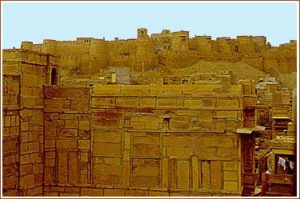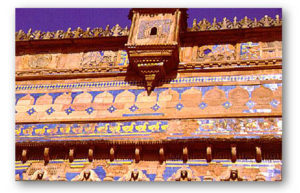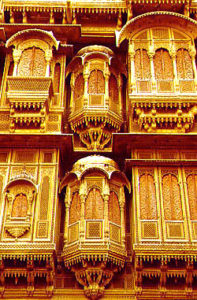-
Rajput architecture is in some sense an anomaly because it is a “Hindu” art dating from a time that is usually described as an “Islamic” period. The Rajputs were a group of warrior clans who lived in what is now Rajasthan and Madhya Pradesh. As Kshatriyas (members of the warrior caste) they considered it their dharma, or divine duty, to fight, and stories of their extraordinary courage on the battlefield are legion. Under British rule, they came to constitute one of the principal ‘martial races’.
Despite their preoccupation with war, the Rajputs were great patrons of art and architecture, the finest examples being their forts and palaces. In contrast to the perfect symmetry of Mughal architecture, Rajput palaces are complex compositions. Generally, most palaces were built as inner citadels surrounded by the city and enclosed by a fortified wall as at Chittorgarh and Jaisalmer. Some forts, such as those at Bharatpur and Deeg, were protected by wide moats.
The oldest surviving palaces date from the mid-fifteenth century and are found at Chitor and Gwalior. The Man Mandir is the largest palace in Gwalior and was built by Raja Man Singh Tomar (1486-1516). Each of these palaces is a complex grouping of small spaces enclosed by a fortified wall. The Man Mandir has two storeys above, and two below, ground level overhanging a sandstone cliff. Here in the underground chambers, royal prisoners were tortured and killed. This gigantic cliff is punctuated by five massive round towers, crowned by domed cupolas and linked by delicately carved parapets. The whole facade is enriched with brilliant blue tiles.
The palaces of Jaisalmer, Bikaner, Jodhpur, Udaipur and Kota represent the maturity of the Rajput style. All of these palaces were built predominantly in the seventeenth and early eighteenth centuries. The huge fortified city of Jaisalmer is situated far out in he Thar desert. The buildings are constructed with the local yellow-brown stone and they have been remarkably preserved owing to their remote location. The fort is enclosed by an imposing 30 feet high sandstone wall. Wells within the fort provided a regular source of water. The fort at Jaisalmer has now acquired another kind of history, becoming a favorite locale for film shootings: even Satyajit Ray shot Sonar Kela (The Golden Fortress) here.
Bikaner was founded in 1488 by Bikha. The city is encircled by a three and a half mile long stone wall in rich pink sandstone. There are five gates and three sally-ports. Junagarh fort was built between 1588 and 1593 by Raja Rai Singh, one of Akbar’s generals. The fort has an excellent library of Persian manuscripts and ancient Sanskrit books and an impressive armoury.The fort at Jodhpur dominates the city and can be seen for miles across the bare desert. The old city is surrounded by a huge wall with 101 bastions, nearly six miles long. The Meherangarh fort stands on a cliff with a sheer drop of over 120 feet.
The foundation of Jaipur, the fabled “pink city”, in 1727 represents the final phase of Rajput architecture. Built by Jai Singh, Jaipur represents a fusion of Eastern and Western ideas of town planning. A huge battlemented wall with bastions and towers at regular intervals, loopholed for musketry, encloses the city. The City Palace is at the center ofthe walled city and is a spectacular synthesis of Rajput and Mughal architectural styles. The Hawa Mahal, or Palace of Winds, (1799) is the building that put Jaipur on the tourist map. The five storey symmetrical facade is composed of 953 small casements in a huge curve each with a projecting balcony and crowning arch. The fact that it is no more, in architectural terms, than a facade points to the continued Indian fascination with dissimulation. This dialectic of illusion and reality is also to be found in the Jantar Mantar, the largest of five observatories built by Jai Singh II in the early eighteenth century. The Jantar Mantar, a scientific and yet playful array of astronomical buildings, is truly the abode of magic.
Sources
Davies, Philip. The Penguin guide to the monuments of India, Vol II. London: Viking, 1989.
Tadgell, Christopher. The History of Architecture in India. London: Phaidon Press, 1990.
Further Reading
Tillotson, G. H. R. The Rajput Palaces, The Development of an Architectural Style. New Haven: Yale University Press, 1987.




